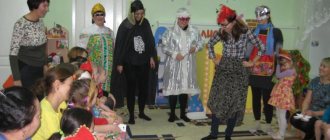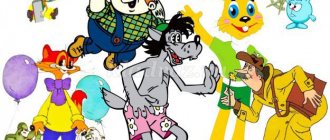Summary of educational activities for children of the middle group “Where the book came to us from”
GCD using ICT “Where the book came to us” in the middle group
Goal: Development of cognitive interest in children.
Tasks:
Educational: Continue to enrich children’s understanding of the world of objects. To form the idea of children that any thing was created by the labor of an adult.
To acquaint children with the history of the origin and production of the book, to give children knowledge of how the book was transformed under the influence of human creativity.
Developmental: develop speech and cognitive activity, the ability to compare, generalize, draw conclusions and inferences.
Educational: to cultivate a caring attitude towards the book - the source of knowledge and wisdom.
Integration of educational areas: “Cognition”, “Speech development”.
Preliminary work:
Looking at colorfully decorated books. Consider what parts the book consists of. Reading riddles, proverbs about books.
Material and equipment:
A box with wooden objects (spoon, egg, cube, plate) and a book inside. Presentation “Book History”, video material “Book History”
Progress of the lesson.
Educator: Guys, look what a wonderful day it is today. The sun has already woken up and looked into our window... Probably, the sun wants to wish us a good mood. What's your mood?
Children: Fun, joyful...
Educator: Do you think we should share our wonderful mood with the people around us?
Children: Of course.
Educator: Then let's greet each other, smile and say: hello neighbor, smile back at me.
— Children, the children from the preparatory group handed me a set of objects. Let's see what lies inside? Children look at the objects in the box.
Game: “Which, which, which, which”
spoon, which one? (wooden)
what kind of ball? (wood)
matryoshka, what kind? (wooden)
what kind of egg? (wooden)
what kind of cubes? (wooden)
- How did the book end up among these objects? (Children's guesses)
The teacher takes the book in his hands.
— The children, the guys from the preparatory group told me an amazing story. It turns out that the book was born in the forest. Are you surprised?
Children: yes. How can it be?
Educator: Here's how: lumberjacks cut down the trees and took them out of the forest. The trees were brought to a paper mill, stripped of bark, sawn, and ground into sawdust. The sawdust was boiled to form a batter-like mass. The wood dough is rolled into long, wide strips and then rolled into huge paper rolls. Then the paper is cut by a special machine into sheets of the required size. And then books are published, but this was not always the case. Sit back comfortably, we are now going to watch a children’s program about how the book appeared and what it was like. (children watch the video “The History of the Book” for 5 minutes).
Employees of the “Childhood” department offer readers a virtual exhibition “How did the book appear?”, dedicated to the history of the emergence of writing and books.
Scientists believe that the history of the birth of the book began with the advent of writing, when primitive hunters made their drawings and inscriptions on the stone walls of ancient caves. As millennia passed, people used a variety of materials, tools and signs to record their thoughts. For example, in India in ancient times they wrote with a needle on palm leaves, in Mesopotamia more than five thousand years ago they covered small clay tablets with cuneiform. The ancient Egyptians wrote on papyrus using complex characters called hieroglyphs. The alphabet, consisting of letters, was used by the ancient Greeks. They also invented wax books: special square-shaped tablets were filled with wax. They wrote on such “pages” with the sharp end of a stick. Residents of ancient Russian cities used small pieces of birch bark for household and economic records. But books in Rus', as in Europe, were made from parchment - finely dressed animal skin. Parchment books were the predecessors of paper books.
The form of books was also varied. For example, in ancient China, when they wrote on bamboo tablets, transporting even one book could require several carts. The ancient Chinese books made of silk that appeared later, like the ancient Egyptian ones made of papyrus, were made in the form of a scroll. But the parchment books looked like a chest, and each one was locked with a padlock.
At a time when there were no printing presses, every book was written and rewritten by hand. Therefore, books were very expensive, and only rich people could buy them. This was the case until the European master Johannes Gutenberg invented the printing press in the 15th century. In Russia, the first printing presses appeared under Tsar Ivan the Terrible. The founder of book printing in Rus' was Ivan Fedorov, and the first printed book, “The Apostle,” was published in 1564. Over the next few centuries, printing developed and improved, and from the 19th century, books became available to everyone.
In our time, the history of the book has received a new development. Nowadays computer technology is used to create books. There are also e-books. And with the help of the Internet you can easily and quickly gain access to the rarest and most valuable publications.
The book exhibition offered to the attention of readers is made up of popular science and fiction literature, which is addressed to children of senior preschool, primary and secondary school age, but will also be of interest to parents and teachers. The exhibition is presented in two sections.
The publications collected in the first section will not only thoroughly acquaint children with the history of books and writing, provide many interesting details, but also tell about modern publishing and library science. Children will learn how a printing house works, what role writers, illustrators, and publishers play in creating books, and how a library works. Smart and beautiful books will teach their readers interesting games with letters and signs, and will reveal the secrets of making unusual homemade books.
The second section presents books from the recent past of printing. Readers can get acquainted with the publications of the late 19th – first half of the 20th centuries, each of which has its own interesting feature. Especially for the exhibition, they were kindly provided by employees of the retro fund of the “Reading Room” sector of the “Adolescence” department. Youth".
Bibliography
Popular science literature
- Valkova, V.G. Knizhkin House / Valentina Grigorievna Valkova, Alexandra Nikolaevna Bedroom. Moscow: Book Chamber, 1990. – 80 p.
- Datskevich, V.P. How a book is made / Viktor Petrovich Datskevich. – Moscow: Children’s literature, 1987. – 25 p.
- Malov, V.I. Book. Children's Encyclopedia / Vladimir Igorevich Malov. – Moscow: Slovo, 2002. – 48 p. : ill.
- Nemirovsky, E.L. Journey to the origins of Russian book printing / Evgeniy Lvovich Nemirovsky. – Moscow: Education, 1991. – 224 p. : ill.
- Osetrov, E.I. The Tale of Drukar Ivan and his books / Evgeniy Ivanovich Osetrov. – Moscow: Malysh, 1979. – 95 p. : ill.
- Pavlov, I.P. About your book / Ivan Prokofievich Pavlov. – St. Petersburg: Children’s literature, 1991. – 113 p. : ill.
- Perehvalskaya, E.V. Where did the alphabet come from / Elena Vsevolodovna Perekhvalskaya. – Moscow: Malysh, 1989. – 25 p. : ill.
- Prudovskaya, S.N. The history of letters with your own hands / Svetlana Nikolaevna Prudovskaya. – Moscow: Compass Guide, 2013. – 84 p. : ill.
- Prudovskaya, S.N. The history of the book with your own hands / Svetlana Nikolaevna Prudovskaya. – 2nd ed., Spanish. – Moscow: Compass Guide, 2012. – 60 p. : ill. – (Do-It-Yourself Books Series).
- Prudovskaya, S.N. The history of the book with your own hands. Continuation / Svetlana Nikolaevna Prudovskaya. – Moscow: Compass Guide, 2014. – 84 p. : ill.
- Acceleration, L.E. Black and white / Lev Emmanuilovich Acceleration. – Moscow: Malysh, 1982. – 30 p. : ill.
Fiction
- Barkov, A.S. Where did the book come from / Alexander Sergeevich Barkov, Ruben Vasilyevich Suryaninov. – Moscow: Malysh, 1974. – 12 p. : ill.
- Be a hero: stories and poems / rep. ed. Leon Cohn. – Moscow: Children’s literature, 1941. – 62 p.
- Zubkov, B.V. A book about a book / Boris Vasilievich Zubkov. – Moscow: Malysh, 1984. – 24 p. : ill.
- Marshak, S.Ya. How your book was published: poem / Samuil Yakovlevich Marshak. – Moscow: Detgiz, 1951. – 8 p. : ill.
- Nekrasov, N.A. Poems for children / Nikolai Alekseevich Nekrasov. – Ivanovo: State Publishing House of the Ivanovo Region, 1937. – 50 p. : ill.
- Pushkin, A.S. The Captain's Daughter: a story / Alexander Sergeevich Pushkin. – Moscow: Children’s literature, 1934. – 128 p.
- Pushkin, A.S. Ruslan and Lyudmila: poem / Alexander Sergeevich Pushkin. – Moscow: Publishing house A.I. Mamontova, 1899. – 47 p. : ill.
- Pushkin, A.S. Fairy tales / Alexander Sergeevich Pushkin. – Germany: Reader Digest Publishing House, 2002. – 223 p. : ill.
- The Tale of Ivan Tsarevich, the Firebird and the Gray Wolf: Russian folk tale. – St. Petersburg: Publication of the expedition for the procurement of state papers, 1901. – 12 p. : ill.




